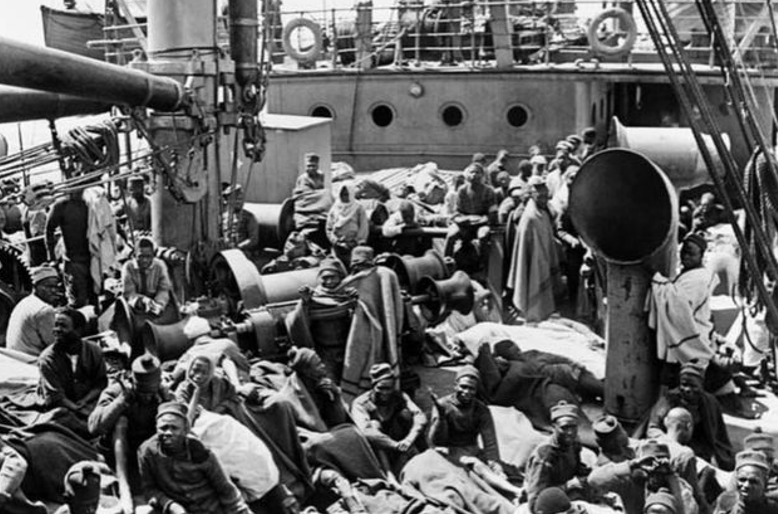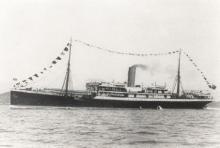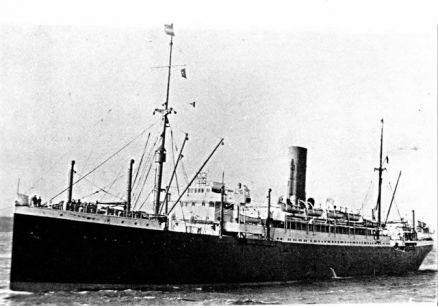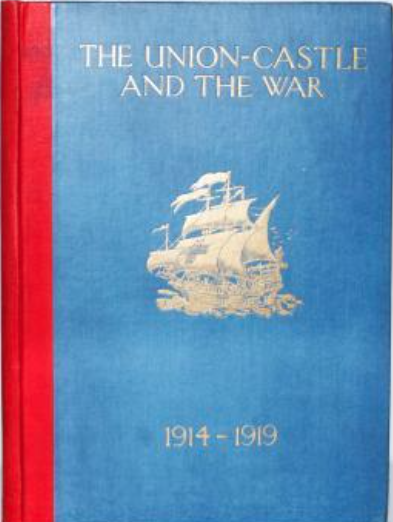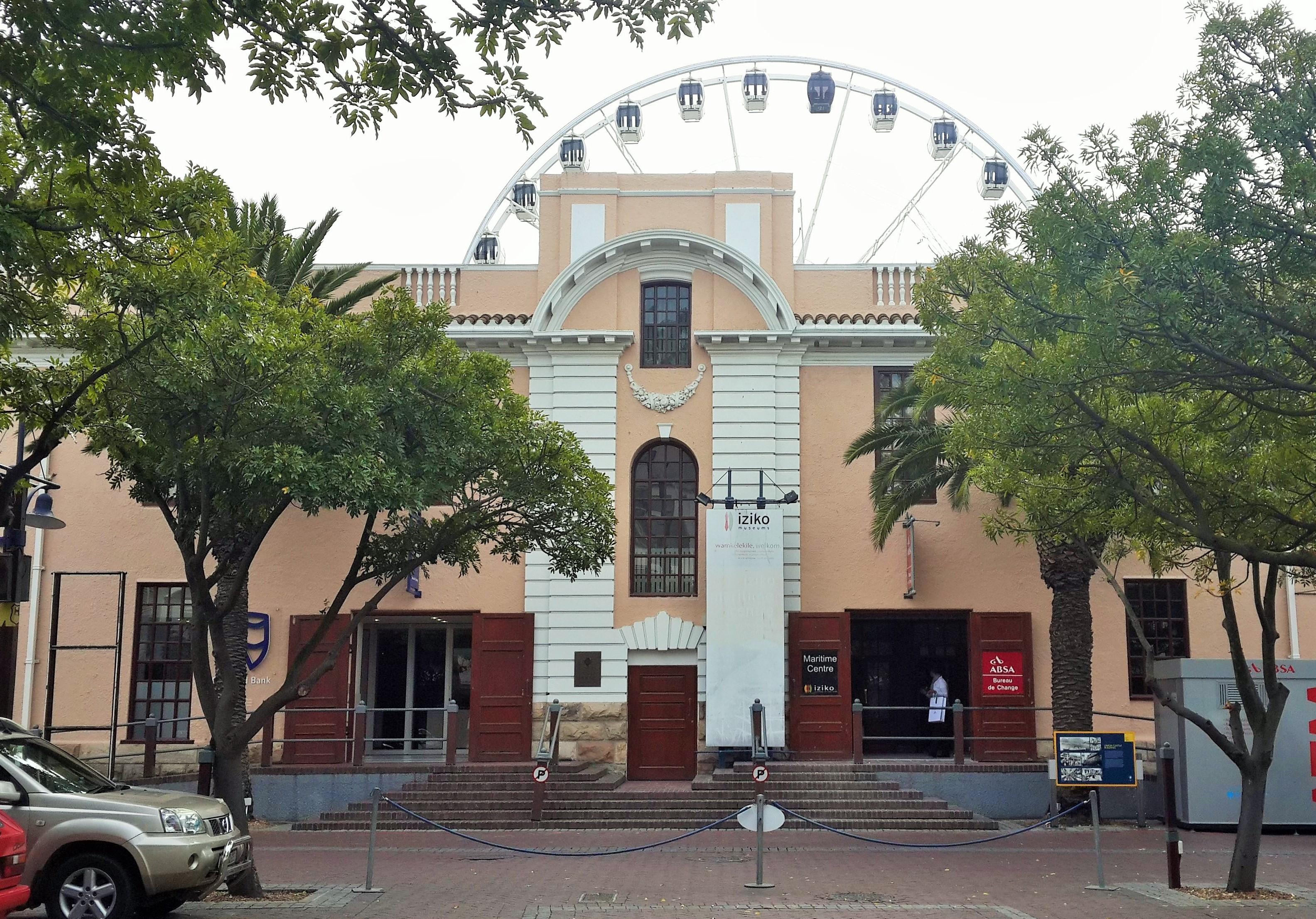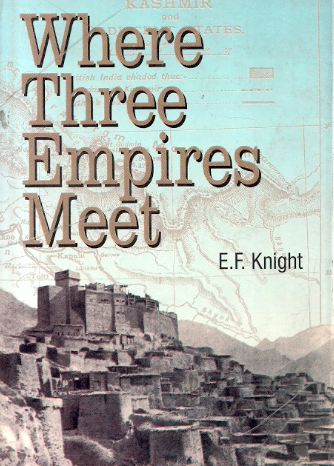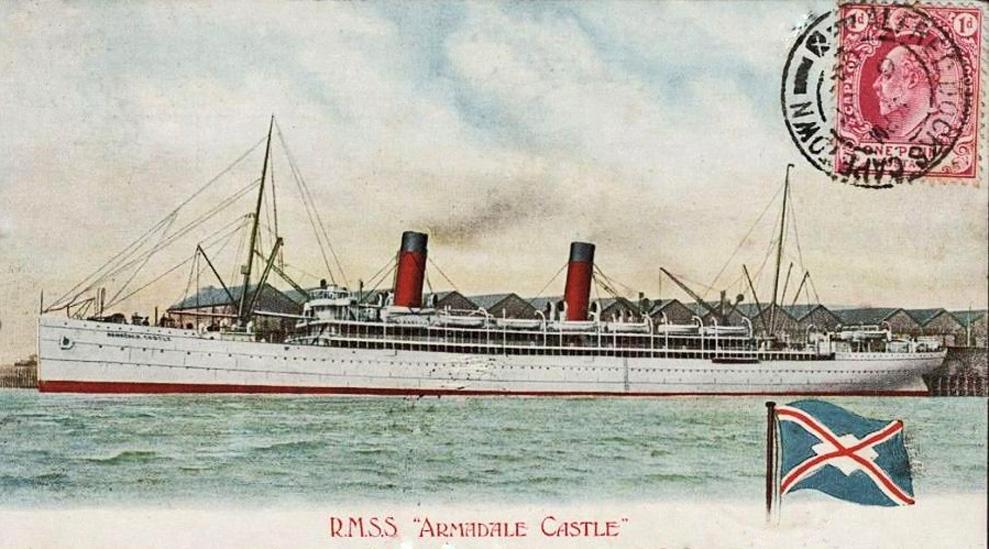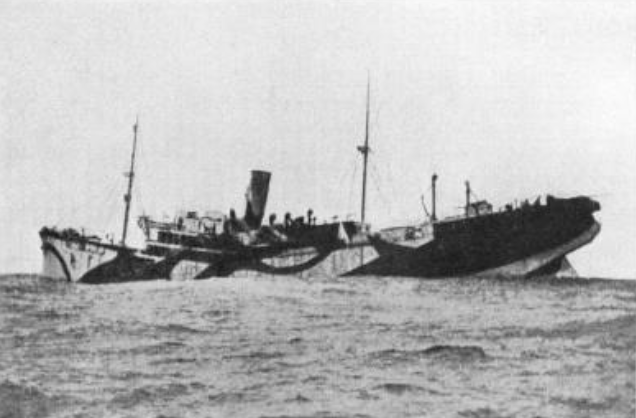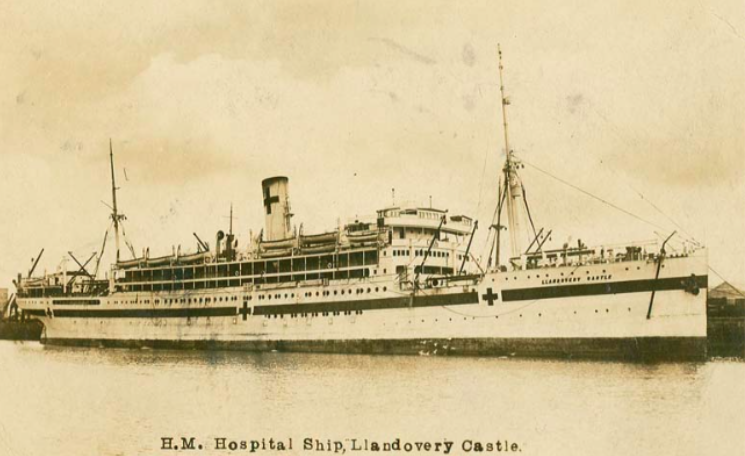
As the 21st February 2018 marked the 101st anniversary of the sinking of the SS Mendi, I thought much about men at sea and the perils of travels by ship during war time. The First World War saw well over 140 ships lost at sea through U-boat action or sinking; there is a page on Wikipedia recording all such disasters where over 30 lives were lost. While we in South Africa recall the loss of the Mendi in 1917 as South Africa’s major military disaster with a loss of 646 men, it was in terms of loss of life only ranked 29th on this Wikipedia list (click here to view full list).
Contemporary photograph of the Men on board the Mendi (Imperial War Museum)
The greatest loss of life occurred in June 1916 when the Italian steamship ship the Principe Umberto, also a troop transport ship was torpedoed by an Austro-Hungarian U-boat and 1926 men of 2821 men were killed.
The most controversial of German naval action was the sinking of the RMS Lusitania, a passenger liner which was torpedoed by the Germans on 7th May 1915 off the coast of Ireland. The ship sank in 18 minutes with a loss of 1,198 out of over 1,900 passengers on board. Over 100 American citizens on the ship lost their lives and hence the sinking of this Lusitania became a cause celebre in motivating the entry of the United States into the First World War on the side of the allies two years later in 1917. The questions posed - was this ship a legitimate military target or was this a passenger ship? Should there not have been a warning? The ship carried munitions as well as passengers and the German argument was that it was simply a naval vessel; no warning ahead of the sinking was given and the Germans believed the ship was armed. The Americans saw the firing of torpedoes as a deliberate act of war as civilians were killed.
The more one dips into naval history of the First World War the more absorbing it becomes. Cargo ships, battle cruisers, dreadnaughts, passenger ships, troopships and hospital ships all became targets for torpedoes and U-boats. Some ships sank through collisions, others exploded. The SS Mendi was a particularly horrible tragedy because it was sunk by the HMS Darro, another British ship. Any and all were at risk. The adoption of a convoy system was a defensive strategy.
SS Mendi (via Wikipedia)
SS Darro (South African Museum of Military History)
This book is one of those unrecognized survivals, in fact treasures, from the First World War. It was privately printed in 1920, as a gift from the Union-Castle company to selected recipients. It was a tribute to the men of the company who lost their lives at sea during the period 1914 to 1919 and is a history of the Union-Castle line during the First World War. It is a particularly handsome book. It is slender with only 63 pages of text but printed on thick card. Each page has a printed border. It is illustrated with pen and ink drawings by the artist Edmund F Fuller. The text is by E F Knight. The end papers show a repeat pattern of the Union Castle logo. The book was bound in publisher's original blue cloth with gilt design & lettering to front & rear.
Book Cover
A roll of honour records all the names of the men who were killed in action plus a record of honours and awards made to Union-Castle men in the concluding section. Many were lost when their ship was torpedoed or mined and some deaths were of men killed in action in France and Belgium. A total of 440 men who were employees of the company died on active service during the war.
This book is in fact the story of the ships of the Union-Castle line lost at sea during the conflict and for this reason it is a fascinating read. I personally have always had a special feeling for Union-Castle history as when I was young I travelled to England via the Windsor Castle in 1968 and returned to South Africa on the same ship in 1971. The role of the Union Castle and its service to South Africa is an aspect of transport history and colonial settlement as well as exploits at sea in war and peace. I now realize that when I was young it was far more common to travel abroad by ship than to fly - for a student it was an awful lot cheaper too! Today, cruise liners are a pleasurable way of sailing to nowhere or somewhere and are a luxury means of holidaying abroad.
The Old Union Castle Building Cape Town - Built shortly after the War (The Heritage Portal)
The author, E F Knight (Edward Frederick) was an interesting writer and far better known in his day than today. His dates were 1852 to 1925. He was an English barrister, soldier, journalist and author of 20 books, many based on his dispatches as a war correspondent in an extraordinary range of the wars of the late 19th century. He was a sailor and wrote about his journey on the Alerte to Trinidad. Knight influenced the writing of Arthur Ransome and then Erskine Childers. A classic travel book written by Knight for which he was best and most enduringly known was “Where Three Empires Meet” about his travels in the conflict ridden area of the Northwest Frontier of Kashmir and the Himalayas. Knight also covered Kitchener’s Sudan expedition, the Spanish American war in Cuba and a French expedition to Madagascar. He was a correspondent in the Anglo Boer War and was wounded in the Battle of Belmont losing his right arm. Another classic book, later reprinted in the Rhodesiana series, was Rhodesia of Today, initially written as a series of dispatches on Matebeleland for The Times, during a visit in 1894. He was also a war correspondent during the Russo-Japanese War of 1904-5. He was a prolific writer. I have four of his books in my library but because they are on such disparate subjects it was only when doing research for this review that I connected the four titles and the author and realized his importance.
Book Cover
The artist E G Fuller (Edmund G Fuller - dates 1858-1940) has contributed some evocative black and white ink drawings of ships of the Union-Castle line and those dramatic moments of small lifeboats awaiting rescue following a sinking. There is an attractive colour plate facing the title page, protected by a tissue guard, of a camouflaged Union-Castle Liner during war time. Edmund Fuller was a marine artist of some note in his day. He was described at the time of his death in 1940 as “barrister, architect, comic artist and metal worker” but it was an artist of seascapes, ships and harbour scenes that he achieved fame. He exhibited at the Royal Academy in 1904 and was a member of the Royal Society of British artists. His work hangs in the Plymouth City Council Art Museum and Gallery as he spent a lot of his time at St Ives. He was also known as a artist of humorous sporting moments, mainly golf and early motoring. He was probably also a book illustrator so it is worth watching out for his work.
The Union-Castle Line was a commercial British shipping company and its full name was the Union-Castle Mail Steamship Company. It operated a fleet of passenger liners and cargo ships between England and South Africa from 1900 to 1977. Its name came from the merger of the Union Line and Castle Shipping Line with both shipping lines active in the run between Southampton and Cape Town and the East coast of Africa. Originally the two companies were both given the mail contract (to avoid a monopoly situation) but ultimately intense competition gave way to cooperation and then finally merger in 1900. During the Anglo Boer War, troop transport was an integral part of their business. Steamships were the work horses conveying mail, cargo and passengers. There were regular weekly sailings, with two passenger ships a week dispatched to South and East Africa. In 1914 the fleet of the company comprised 43 vessels but during the war regular commercial service gave way to British government take over, management and control with their functions extended to that of troop and stores carriers to far places such as Archangel, Gallipoli, Egypt and Mesopotamia and then serving as hospital ships to bring the wounded home. The Elder Dempster line, the owner of the SS Mendi, underwent a similar transformation. The Union-Castle ships carried a large part of the First Expeditionary Force to France. There is a fascinating story of how Kitchener arranged for the diversion of the Edinburgh Castle in August 1914 en route from South Africa with mail and 1200 men on board to Gibraltar to convey a battalion back to England, using wireless technology to intercept the ship.
During the war an important duty of the Union-Castle ships was to convey wounded men from fighting arenas back to Britain. These steamers landed a total of nearly 340 000 British soldiers and included in that number were more than 8 000 enemy wounded. Six of the company’s hospital ships were torpedoed or mined, of which four were totally lost. Some merchant vessels were also fitted out as armed merchant cruisers. For example, the popular Armadale Castle and the Kinfauns Castle were refitted as armed vessels. The merchant service over time adapted not only to their new armed status but to the convoy system to keep these vital sea trade routes open.
Armadale Castle (via Wikipedia)
One Union-Castle hospital ship that was torpedoed and lost was the Llandovery Castle, bound from Halifax, Nova Scotia for Liverpool in June 1918 (see main image). It carried 258 people including medical officers and nursing sisters of the Canadian Medical staff. Knight tells the story in graphic detail of what happened. Lifeboats were launched but of the total complement on board, the sole survivors were 24 people in the captain’s boat. The strange aspect of this sea disaster was the conversation between the German attackers and the Captain and men in his life boat. The Germans emphasised that the ship carried American flight officers and this was their reason for the attack. The Llandovery Castle was one of five Canadian hospital ships that served in World War 1 and its sinking was the deadliest Canadian naval disaster of the war. There was an equally strange sequel (not related by Knight). In 1921, the captain of the U-boat that sank the Llandovery Castle, a Lieutenant Helmut Patzig, was charged with war crimes and the case became famous as the Leipzig trials, but then the case collapsed on appeal.
Two ships lost during the war were the Leasowe Castle and the Galway Castle. The H.M.T. Leasowe Castle (a 10 000 ton ship) was torpedoed by a German submarine on 27 May 1918 with the loss of 93 lives. She was travelling in a convoy 104 miles north-west of Alexandria and sank within 90 minutes. It was remarkable that over 2,800 men survived the sinking by taking to life rafts, lifeboats, the Japanese destroyer "R" and H.M. Sloop "Lily". The Captain of the Leasowe Castle, a Captain Edward Holl went down with his ship and actually in the final moment of the sinking gave the order “every man for himself“. Holl was age 50 when he died.
Galway Castle (via forgottenwrecks.maritimearchaeologytrust.org)
The story of the Galway Castle is better known and Knight’s account has become a classic source of information frequently quoted online. The ship was bound for the Cape and left Plymouth on 10th September 1918. Its total complement of passengers was 952. This comprised some 346 civilian passengers (53 first class, 109 second class and 184 third class) and 399 invalided troops together with a crew of over 200. The Galway Castle initially travelled in convoy but on the 12th September when the convoy dispersed and the larger liner moved at greater speed, the Galway was struck by a German torpedo. It was anticipated that the ship would sink and hence the order was given by Captain Dyer for boats to be lowered and evacuation of all on board to follow. There were two remarkable aspects to this disaster. Firstly, of the approximately 1000 people on board the loss of life added to 143 souls. Secondly, Dyer and some volunteers remained on board and while it was anticipated that the ship would disappear quickly it actually stayed afloat for some three days and all who remained on board were rescued whereas many of the passengers were lost. Knight does not cover the stories of any of the passengers but among those who were on board were some distinguished South Africans including Sir Ernest Oppenheimer (his story told by his son Harry in a tribute), Mrs Jose Dale Lace, the Hon H Burton, the Union Minister of Finance, and Mrs Winifred Murra. They were all survivors but children were lost. Daphne Saul’s book on Mrs Dale Lace is wrong in claiming that only 143 were saved. The figures are the exact reverse. The website Forgotten wrecks of the First World war states: “Records suggest that at least 143, and perhaps more than 150, lives were lost.” Another lesser known person lost in this tragedy was a Constance Addison age 25 who was a probationer nurse and who had served as a member of the S A Military nursing service at the South African military hospital at Richmond Park in London.
This book is a rich source of information about a shipping company with a strong South African connection so it fits into the literature of the First World War, naval history, Africana as well as South African shipping history. The distinction of the author and the illustrator make it a collectable work in its own right.
Anyone interested in South African genealogical history will find this book of great appeal.
Kathy Munro is an Honorary Associate Professor in the School of Architecture and Planning at the University of the Witwatersrand. She enjoyed a long career as an academic and in management at Wits University. She trained as an economic historian. She is an enthusiastic book person and has built her own somewhat eclectic book collection over 40 years. Her interests cover Africana, Johannesburg history, history, art history, travel, business and banking histories. She researches and writes on historical architecture and heritage matters. She is a member of the Board of the Johannesburg Heritage Foundation and is a docent at the Wits Arts Museum. She is currently working on a couple of projects on Johannesburg architects and is researching South African architects, war cemeteries and memorials. Kathy is a member of the online book community the Library thing and recommends this cataloging website and worldwide network as a book lover's haven.

